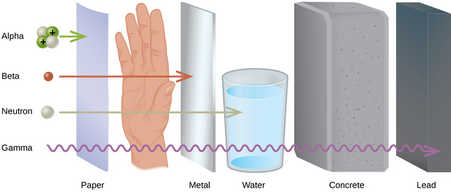Radioactive decay
From WikiLectures
Radioactive decay is a phenomenon in which unstable atoms emit their energy in the form of particles or electromagnetic waves. It is a random event, so we are not able to predict what core and when it will transform. Radioactive decay is determined by the so-called decay constant , which has a different value for each radioisotope. There are 3 basic types of decay – alpha, beta and gamma.
Table showing the characteristics of individual types of decay:
| character of the elements | emitted particles | radiation character | spectrum type | absorption | degree of ionization in the organism | |
|---|---|---|---|---|---|---|
| alpha decay | heavy and naturally radioactive | alpha particle (helium) | it often deviates | linear | paper, layer of air | big |
| beta decay | light (artificial radionuclides) | electron neutrino | it often deviates | continuous | aluminum sheet | medium |
| gamma decay | photons emitted by the nucleus | photons | it does not deviate | linear | lead, duralumin | weak |
Links[edit | edit source]
Related Articles[edit | edit source]
Resources[edit | edit source]
- BENEŠ, Jiří – JIRÁK, Daniel – VÍTEK, František. Základy lékařské fyziky. 4. edition. nakladatelství Karolinum, 2015. ISBN 978-80-246-2645-1.

